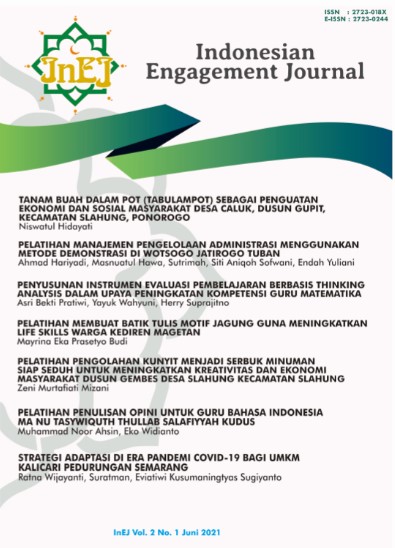PELATIHAN MEMBUAT BATIK TULIS MOTIF JAGUNG GUNA MENINGKATKAN LIFE SKILLS WARGA KEDIREN MAGETAN
DOI:
https://doi.org/10.21154/inej.v2i1.3104Keywords:
Training, Batik, Life skills, Kediren Village.Abstract
Mayoritas warga Desa Kediren bermata pencaharian sebagai petani jagung. Selain bertani, terkadang masyarakat juga membuat batik sebagai mata pencaharian tambahan. Industri batik tulis Desa Kediren Kabupaten Magetan baru berjalan enam bulan. Industri batik tulis motif jagung sebagai ikon kebanggan Desa Kediren belum berjalan dengan baik dikarenakan keterbatasan sumber daya manusia yang memiliki kemampuan membuat batik. Tujuan pengabdian yang kami lakukan adalah meningkatkan life skills membuat batik tulis motif jagung bagi warga. Metode yang digunakan dalam pengabdian iniadalah Asset Based Communities Development (ABCD) yaitu melakukan pelatihan dengan praktik membuat batik tulis motif jagung bersama warga dengan fasilitator salah satu warga yang sudah lebih kompeten dalam membuat batik tulis motif jagung. Hasil dari pengabdian masyarakat menunjukkan meningkatnya kemampuan warga dalam membuat batik tulis motif jagung. Mereka lebih terampil dan batik yang dihasilkan lebih bagus dari sebelumnya.Jadi pelatihan ini penting guna meningkatkan life skills dalam membuat batik tulis motif jagung warga Desa Kediren Kabupaten Magetan.
The majority of Kediren Village residents work as corn farmers. Apart from farming, sometimes people also make batik as an additional source of income. The batik industry in Kediren Village, Magetan Regency, has only been running for six months. The batik industry, with corn motifs as the proud icon of Kediren Village, has not been running well due to limited human resources who have the ability to make batiks. The goal of our dedication is to improve life skills by making batik with corn motifs for the residents. The method used in this service is Asset Based Communities Development (ABCD), which is training by practicing making written batik with corn motifs together with the community with the facilitator, one of the residents who is more competent at making batik with corn motifs. The results of community service show the increasing ability of residents to make batik with a corn motif. They are more skilled and the batik they produce is better than before. So, this training is important in order to improve life skills in making written batik with corn motifs in Kediren Village, Magetan Regency.
References
Faisal, S., (1992), Format-format Penelitian Sosial. Jakarta: Rajawali Press.
Indrati, A.dkk., (2011), “Pengembangan Dokumentasi Elektronik Batik Jawa, Bali dan Madura Berbasis Web,” laporan penelitian, Jakarta: Universitas Gunadarma,
Kusrianto, A., (2014), Batik, Filosofi, dan Kegunaan. Yogyakarta: Penerbit Andi.
Mahmudah, N & Supiah., (2018), “Pemberdayaan pada Anak-anak Gang Dolly di SMA Artantika Surabaya dengan Metode Asset Based Community Development,” Jurnal Madani , Vol 1 no 1,
Margaria (2019), “Jenis-jenis batik menurut cara pembuatannya,” http://margaria.co.id, akses 1 Oktober 2019
Nurainun (2010), “Analisis Industri Batik di Indonesia,” Jurnal Fokus Ekonomi.
Sari, I.P.dkk., (2018), “HKI pada Batik Tulis Indonesia (Studi Kasus Batik Tulis Tanjung Bumi, Madura),” Jurnal Ekonomi Pendidikan dan Kewirausahaan Unesa, (2018).
Singgih, (2016), “Karakteristik Motif Batik Kendal Interpretasi dari Wilayah dan Letak Geografis,” Jurnal Imajinasi.
Siregar, A.P.dkk., (2020), “Upaya Pengembangan Industri Batik Di Indonesia: Dinamika Kerajinan dan Batik,” Majalah Ilmiah Vol 37 No.1.
Suliyanto, Novandari, W., & Setyawati, S.M., (2015), Persepsi Generasi Muda Terhadap Profesi,
Utami, A.D., & Triyono, R.A., (2011), “Pemanfaatan Blackberry Sebagai Sarana Komunikasi dan Penjualan Batik Online dengan Sistem Dropship di Batik Solo 85,” Jurnal Speed_Sentra Penelitian Engineering Dan Edukasi, https://doi.org/10.3112/speed.v4i4.1099.
Wahono. Dkk., (2004), Ragam Hias Batik (Tinjauan Makna dan Simbol), Semarang: Pemerintah Daerah Propinsi Jawa Tengah, Dinas Pendidikan dan Kebudayaan Museum Jawa Tengah “Ronggowarsito”,
Wulandari, (2011), Batik Nusantara Makna Filosofis, Cara Pembuatan dan Industri Batik. Yogyakarta: Andi OFFSET.
Downloads
Published
Issue
Section
License
Please find the rights and licenses in InEJ. By submitting the article/manuscript of the article, the author(s) agree with this policy. No specific document sign-off is required.1. License
The non-commercial use of the article will be governed by the Creative Commons Attribution license as currently displayed on Creative Commons Attribution-NonCommercial-ShareAlike 4.0 International License.
2. Author(s)' Warranties
The author warrants that the article is original, written by stated author(s), has not been published before, contains no unlawful statements, does not infringe the rights of others, is subject to copyright that is vested exclusively in the author and free of any third party rights, and that any necessary written permissions to quote from other sources have been obtained by the author(s).
3. User/Public Rights
The spirit of InEJ is to disseminate articles published are as free as possible. Under the Creative Commons license, InEJ permits users to copy, distribute, display, and perform the work for non-commercial purposes only. Users will also need to attribute authors and InEJ on distributing works in the journal and other media of publications. Unless otherwise stated, the authors are public entities as soon as their articles got published.
4. Rights of Authors
Authors retain all their rights to the published works, such as (but not limited to) the following rights;
Copyright and other proprietary rights relating to the article, such as patent rights,
The right to use the substance of the article in own future works, including lectures and books,
The right to reproduce the article for own purposes,
The right to self-archive the article,
The right to enter into separate, additional contractual arrangements for the non-exclusive distribution of the article's published version (e.g., post it to an institutional repository or publish it in a book), with an acknowledgment of its initial publication in this journal (InEJ: Indonesian Engagement Journal).
5. Co-Authorship
If the article was jointly prepared by more than one author, any authors submitting the manuscript warrants that he/she has been authorized by all co-authors to be agreed on this copyright and license notice (agreement) on their behalf, and agrees to inform his/her co-authors of the terms of this policy. InEJ will not be held liable for anything that may arise due to the author(s) internal dispute. InEJ will only communicate with the corresponding author.
6. Royalties
Being an open accessed journal and disseminating articles for free under the Creative Commons license term mentioned, author(s) aware that InEJ entitles the author(s) to no royalties or other fees.
7. Miscellaneous
InEJ will publish the article (or have it published) in the journal if the article’s editorial process is successfully completed. The editors of Journal may modify the article to a style of punctuation, spelling, capitalization, referencing and usage that deems appropriate. The author acknowledges that the article may be published so that it will be publicly accessible and such access will be free of charge for the readers as mentioned in point 3.




